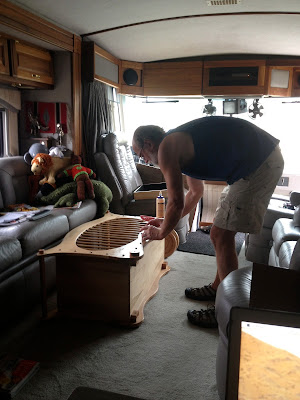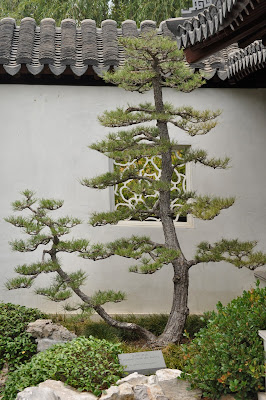Nora Mae, aka Princess Burton.
Day 2...Man, this whole wide-open-world thing is tiring!
Mom watching Opa.
Opa checking out the new arrival.
Bonding with Opa.
We are hanging out in Seal Beach, CA on the south end of the Los Angeles area. The Seal Beach Naval Weapons Station has a wonderful RV park just off an inlet from the ocean - it is one of the cleanest and best-kept camps we've been in so far.
View from the living room.
A large part of the naval base is the Seal Beach Wildlife Refuge. There's a great little native plant botanical garden behind the ranger station and I've spent some wonderful time there with my camera in hand. Well, I could NOT stay away - Heinz politely declined to keep going down with me and stayed home to work on the toy box.
Island Morning Glory
Bush Sunflower
Matilija Poppies, each bloom is bigger than my hand!
Heinz putting on the final touches.
Ready to hit the road to their new home.
Excited new mom checking it all out.
Hmmm, which do I like the best?
Of course we have tried some "local" restaurants - local in L.A. can be up to 30-40 miles across town and 1 to 2 hours away in traffic, so we go when we're already out and about. The "kids" introduced us to one of their favorite pizza places, Pitfire Artisan Pizza. It's a local chain that serves individual sized pizzas, salads, and pasta dishes. Heinz opted for the Sausage Pizza with sweet fennel sausage, tomato sauce, fontina and mozzarella cheeses and red onion. I decided to be a bit more eclectic and went for the "Be an Artist" pizza and chose my own ingredients: mozzarella and goat cheeses, basil, and mixed mushrooms (button, oyster and shitake). Both were quite yummy.
Heinz has been collecting stories about local restaurants from Sunset Magazine, so we've tracked down a couple of them. The other day we dropped in at Umami Burgers. This is a local chain with a somewhat limited menu, but wow, what a taste sensation. Heinz chose the Truffle Burger, house-made truffle cheese with a truffle glaze and I went for the Hatch Burger, 4 kinds of green chiles and house-made white cheddar cheese. The burgers looked pretty small when they arrived, but we walked out stuffed. The burgers are house-ground, hand-formed patties and the sauces, cheeses, and house-baked buns just keep upping the flavor. We both agreed that this was one of the best burgers either one of us has ever had.
Umami Burger
Another spot on Heinz's list is Wurstkuche. This restaurant features 20 or so different sausages with various toppings. Heinz and Jess ordered the Hot Italian while I decided to try one of the "exotic" sausages and got the lamb with Mediterranean spices. They were both fantastic! In fact, they were so good, Heinz and I got a second round.
Last night we went to Walt's Wharf in Seal Beach as I was craving fresh seafood. This is a nice place about a block off the beach in downtown Seal Beach. It was a relaxing place with excellent food.
My choice, bacon lacquered carmelized jumbo scallops.
Heinz tried the Cioppino - seafood stew with clams, mussels, crab, shrimp, and scallops.
First up in activities was a night at the Hollywood Bowl to see Emmylou Harris in concert. It was a great night for a concert - the weather was perfect, the crowd was friendly, and the music enjoyable. We packed up snacks of summer sausage and smoked salmon (thanks, Bill and Connie, they were great!), cheeses, crackers and a nice bottle of white Zin. Before the performances began and during the breaks, we snacked and watched the crowd.
The Bowl is the largest natural amphitheater in the U.S., with seating of nearly 18,000. It opened in 1922 and for the first 5 years featured crude wooden benches for the audience and an open stage for the performers. In 1927, Frank Lloyd Wright's son, Lloyd Wright built a pyramidal shell out of left-over lumber from a production of Robin Hood. This has been regarded as the best shell the Bowl ever had from an acoustic standpoint. However, the Southwestern design was considered to be too avant-garde, and it was demolished at the end of the season. Lloyd Wright tried again in 1928 with a fiberglass shell in the shape of concentric 120-degree arches, with movable panels that could be used to tune the acoustics. It was designed to be easily dismantled and stored between concert seasons. For some reason this was not done and the shell did not survive the winter. In 1929 Allied Architects built the shell that stood until 2003 when it was replaced with the current shell. This one incorporates the prominent front arch of the 1926 shell, the broad profile of the 1928 shell, and the unadorned white finish and general lines of the 1929 shell.
Hollywood Bowl
Next up was the La Brea Tar Pits and the Page Museum, devoted to displays of fossil findings in the pits. This was one of the places we always wanted to see when we were stationed at Edwards AFB, but never quite got around to. Tar pits are composed of heavy oil fractions called asphaltum, which seeps from the earth. The La Brea Tar Pits seep from the Salt Lake Oil Field, which lies under much of the Fairfax District of downtown Los Angeles. The oil reaches the surface and forms pools at several locations in Hancock Park, becoming asphalt as the lighter fractions of the oil evaporate.
This seeping has been happening for tens of thousands of years. From time to time, the asphalt would form a layer 2-4 inches deep - enough to trap even the largest of animals. The surface would be covered with layers of water, dust, or leaves. Animals would wander in, become trapped, and eventually die from starvation, dehydration, or attack by predators. If attacked, the predators would often also became stuck - their skeletons are now being excavated. Since most of the predators at that time hunted in packs there are many more predator bones (versus prey) found in pit excavations. Among the species associated with the La Brea Tar Pits are mammoths, dire wolves, short-faced bears, ground sloths, and saber-toothed cats. Paleontologists have also discovered fossilized insects, plants, and pollen grains. Only one set of human remains has been found, a partial skeleton of a woman, dated to approximately 10,000 years ago.
One of the La Brea Tar Pits with a mammoth statue.
Close-up of the tar surface, the bubbles are caused by methane gas being released.
Entrance to the Page Museum.
Dire wolves on the prowl.
Mammoth skeleton on display.
See and touch station, showing off a saber cat head.
After strolling around the Page Museum we headed across the park to the Los Angeles County Museum of Art, better known as LACMA. This is the largest art museum in the western U.S., attracting nearly a million visitors annually. Its holdings of more than 100,000 works span the history of art from ancient times to the present. The collections are housed in five buildings and include some of the world's most famous art and many more less well-known, but fabulous artworks.
The Treachery of Images (This is Not a Pipe), Rene Magritte, 1929.
Madonna made of gessoed cloth, 1700's
Draped Christ figure, plaster, 1600's.
Egyptian mummy.
Last Friday we headed out to the Huntington Library and Botanical Gardens. Heinz seemed a little hesitant, but was willing to take me. Turns out he thought I was wanting to go to a local library that had a garden by it - boy, was he surprised. The Huntington is a collections-based research and educational institution founded in 1919 by Henry Huntington, a Los Angeles businessman who made a fortune in railroads, utilities, and real estate holdings in Southern California. During his lifetime, he amassed the core of one of the finest research libraries in the world, established a significant art collection, and created botanical gardens with plants from all over the world. The Huntington is located on 207 acres in Pasadena and is an oasis in the middle of the city.
The Library is considered one of the largest and most complete research libraries in the fields of British and American history and literature. On display among other rare books is a Gutenberg Bible printed on vellum in 1450, the first major book printed on movable type in the western world (Chinese printers had already been printing with movable type using a different process).
There are three buildings holding the art collections and rotating special exhibits. The Huntington Art Gallery, completed in 1911, was originally the Huntingtons' residence. Highlights of the 18th century art include Gainsborough's Blue Boy and Houdon's bronze Diana the Huntress. The Virginia Scott Gallery holds American art including works by Mary Cassatt, Edward Hopper, and Frederic Church. The Chandler Building provides space for temporary exhibitions. The current exhibit is prints featuring California wildflowers.
The Chandler Building.
Mojave Tulip
California Poppies.
The Gardens consist of more than a dozen themed gardens covering 120 acres. Among the most remarkable are the Desert garden with mature cacti and other succulents from around the world; the Japanese Garden featuring a Japanese teahouse and moon bridge; and the Chinese Garden with a lake, and five stone bridges.
Garden statuary.
Barrel cacti in the Desert Garden.
Wooly Torch, native of Bolivia.
White Glory cactus, native of Sonora Desert.
One of many jasmine beds. Sure wish I could send the fragrance along with this picture, Heavenly!
Entrance to the Japanese Garden.
Gardenia in the Japanese Garden. Once again, the scent was wonderful.
Water lily in the Chinese Garden pond.
Magnolia blossom, these trees were all over the grounds.
Columbine in the Shakespeare Garden.
We have other plans pending for sights around the city interspersed with oohing and cooing at the baby. In the meantime, here are our friends of the day.
Yeah, yeah, I'm just not impressed by that saber-toothed cat...
Ground squirrels are EVERYWHERE around the park.
Beverly trying to figure out why Heinz quit scratching her.
Boris, bored with us all.
Please come out and play!! (Beverly urging the baby on)
Clementine exploring the living room.














































No comments:
Post a Comment